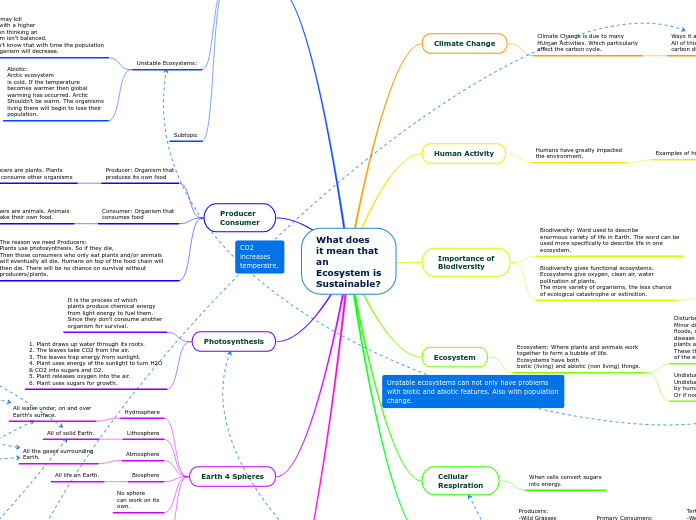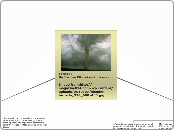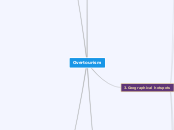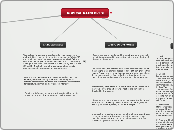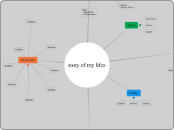What does
it mean that
an
Ecosystem is
Sustainable?
What humans can do
We can find ways to
prevent damage to the
ecosystem. And keep it
sustainable.
These are a few.
Don't travel as much.
Flights emit CO2.
Recycle things or
throw things into garbage
instead of lazily dropping them
outside. Which is called littering.
Unplug
devices when
not using them.
To reduce using
electricity.
Reduce
Reuse
Recycle
Earth 4 Spheres
The biosphere receives gases, heat, and sunlight (energy) from the atmosphere.
It receives water from the hydrosphere and a living medium from the geosphere.
No sphere
can work on its
own.
Biosphere
All life on Earth.
Atmosphere
All the gases surrounding
Earth.
Lithosphere
All of solid Earth.
Hydrosphere
All water under, on and over
Earth's surface.
Photosynthesis
1. Plant draws up water through its roots.
2. The leaves take CO2 from the air.
3. The leaves trap energy from sunlight.
4. Plant uses energy of the sunlight to turn H2O
& CO2 into sugars and O2.
5. Plant releases oxygen into the air.
6. Plant uses sugars for growth.
It is the process of which
plants produce chemical energy
from light energy to fuel them.
Since they don't consume another
organism for survival.
Producer
Consumer
The reason we need Producers:
Plants use photosynthesis. So if they die,
Then those consumers who only eat plants and/or animals
will eventually all die. Humans on top of the food chain will then die. There will be no chance on survival without producers/plants.
Consumer: Organism that
consumes food
Consumers are animals. Animals
don't make their own food.
Examples:
-Weasel
-Hawk
-Red Squirrel
Producer: Organism that
produces its own food
Producers are plants. Plants
don't consume other organisms
Examples:
-Grass
-Trees
-Fruits
-Algae
Biome
Subtopic
Unstable Ecosystems:
Abiotic:
Arctic ecosystem
is cold. If the temperature
becomes warmer then global
warming has occurred. Arctic
Shouldn't be warm. The organisms
living there will begin to lose their
population.
Biotic:
Humans may kill
animals with a higher
population thinking an
ecosystem isn't balanced.
They don't know that with time the population
of the organism will decrease.
A biome is a geographical region
defined by climate. It has specific
Biotic and Abiotic Features.
Example: Boreal Forest
Abiotic Features:
-Warmer than tundra
-No permafrost
-Changeable weather
-Soil contains some water
and is acidic precipitation
-40 cm/yr or more
Biotic Features:
-Coniferous trees
-Seed eating birds
-Squirrels
-Voles
-Snow shoe hares
-Black bears
-Pine martens
-Grey wolves
Abiotic: Non Living Features
Biotic: Living features
Food Web
Say the population of Hares decrease.
The organisms who eat the Hare
(Lynx, Goshawk, Great Horned Owl)
will eventually have their population decrease.
Then, more of those organisms will eat the
Red Squirrel. So the Red Squirrel's population will
decrease.
This means, the plants the Red Squirrel eats,
such as Pine Trees, will begin to increase.
Then the Primary Consumers' populations
will eventually rise again.
All of this makes a balanced Ecosystem.
In which humans have disrupted.
Producers:
-Wild Grasses
-Aspen Tree
-Blueberry Bush
-Pine Tree
Primary Consumers:
-Snowshoe Hare
-Red Squirrel
Tertiary/Secondary Consumers:
-Weasel
-Lynx
-Goshawk
-Great Horned Owl
Cellular
Respiration
When cells convert sugars
into energy.
Ecosystem
Ecosystem: Where plants and animals work
together to form a bubble of life.
Ecosystems have both
biotic (living) and abiotic (non living) things.
Undisturbed Ecosystem:
Undisturbed if it hasn't been altered
by humans. Such as trees being cut down.
Or if none of those minor disturbances occur.
Disturbed Ecosystem:
Minor disturbances include
floods, small wildland fires and
disease outbreaks through
plants and animals.
These things can change the populations
of the ecosystem.
Importance of
Biodiversity
Biodiversity gives functional ecosystems.
Ecosystems give oxygen, clean air, water
pollination of plants.
The more variety of organisms, the less chance
of ecological catastrophe or extinction.
Bonus: Variety of life on Earth
can give us many fun things to do. Recreational
activities may rely on unique biodiversity.
Examples: Birdwatching, Fishing, Camping.
Biodiversity: Word used to describe
enormous variety of life in Earth. The word can be
used more specifically to describe life in one
ecosystem.
Human Activity
Humans have greatly impacted
the environment.
Examples of human impact:
-Cut down trees
-Dumping Mercury in the river
-Burning Fossil Fuels
-Non Native species
What these things have caused:
Humans don't always cause Non Native Species,
but they are responsible for a lot of them.
Without thinking, bring species into a new ecosystem.
That species becomes so invasive, that it eventually transfers
into this new ecosystem.
-Burning Fossil Fuels: Caused climate change. Burning fossil fuels such as coal and oil has increased the concentration of
atmospheric carbon dioxide.
-Mercury in the river: People rely on eating fish and/or drinking water from the river. They get mercury poisoning.
-Cutting down trees: Animals have lost
their habitat.
Climate Change
Climate Change is due to many
HUman Activities. Which particularly
affect the carbon cycle.
Ways it affects the carbon cycle:
All of this increases the amount of
carbon dioxide in the atmosphere.
Transportation.
Vehicles emit CO2.
Industrialized agriculture:
Use of artificial pesticides and
artificial fertilizers, can leach into
groundwater. It is toxic to people
and animals.
Clear cutting forests.
